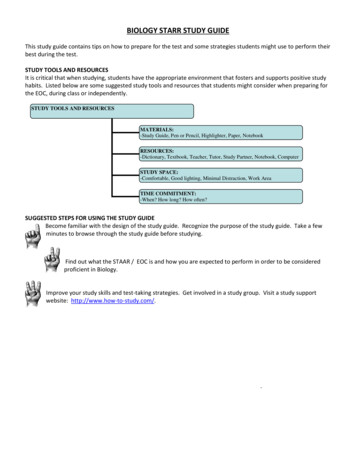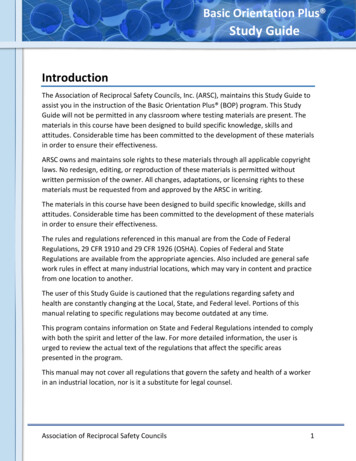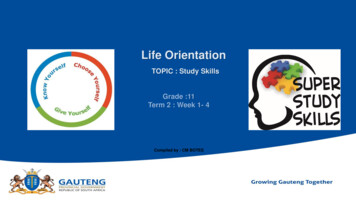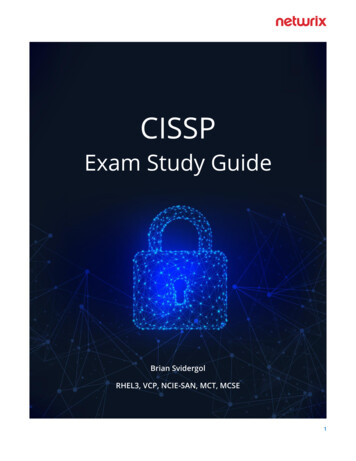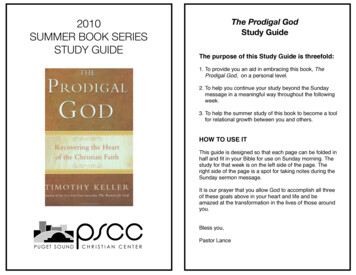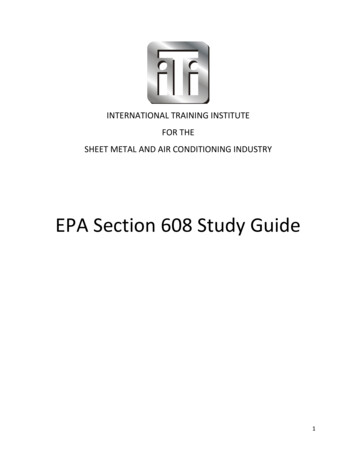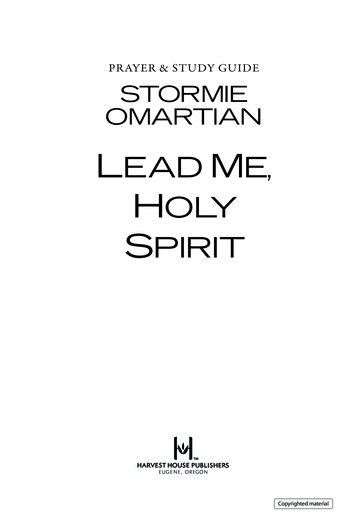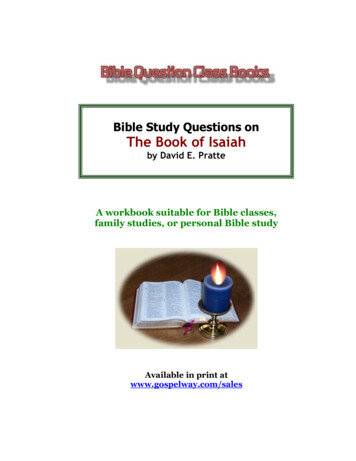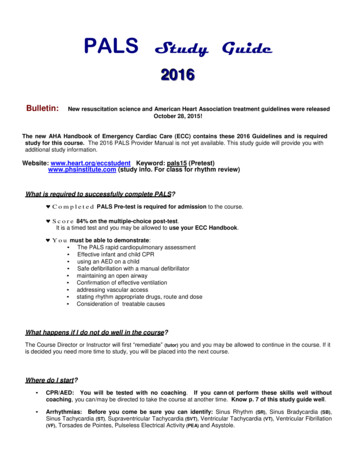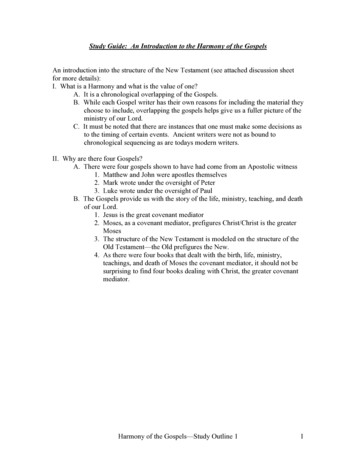
Transcription
Study Guide: An Introduction to the Harmony of the GospelsAn introduction into the structure of the New Testament (see attached discussion sheetfor more details):I. What is a Harmony and what is the value of one?A. It is a chronological overlapping of the Gospels.B. While each Gospel writer has their own reasons for including the material theychoose to include, overlapping the gospels helps give us a fuller picture of theministry of our Lord.C. It must be noted that there are instances that one must make some decisions asto the timing of certain events. Ancient writers were not as bound tochronological sequencing as are todays modern writers.II. Why are there four Gospels?A. There were four gospels shown to have had come from an Apostolic witness1. Matthew and John were apostles themselves2. Mark wrote under the oversight of Peter3. Luke wrote under the oversight of PaulB. The Gospels provide us with the story of the life, ministry, teaching, and deathof our Lord.1. Jesus is the great covenant mediator2. Moses, as a covenant mediator, prefigures Christ/Christ is the greaterMoses3. The structure of the New Testament is modeled on the structure of theOld Testament—the Old prefigures the New.4. As there were four books that dealt with the birth, life, ministry,teachings, and death of Moses the covenant mediator, it should not besurprising to find four books dealing with Christ, the greater covenantmediator.Harmony of the Gospels—Study Outline 11
Gospel ProloguesI. Luke 1:1-4A. Note Luke’s language of having done research in preparation of this Gospel1. He is seeking to “compile” a narrative-implication is that he is drawing from many sources2. He has spoken to eyewitnesses and “ministers” or “helpers”a. Luke quotes extensively from Mark, the earliest gospel writer,and a “helper” of Peter, this is most likely a reference to Markas a sourceb. Note the relationship to inspiration and research—Godinspiration does not imply sloppy or incomplete preparationB. Also note Luke’s emphasis on putting forth an “orderly” or“chronological” account1. a reflection of his Greek way of thinking2. a reminder that the Hebrew writers, Matthew, Luke, and Johnsometimes moved narratives out of their chronological orderingto make a theological point3. Likely Luke’s account is chronologically most straight-forwardII. John 1:1-18A. Verse 1-21. Note allusion to Genesis 1:1a. John is emphasizing the pre-existence of the Word (Jesus)b. John is also emphasizing the Trinitarian language about therelationship of the Father and the Soni. different personsii. same essencec. language also rejects Christological errori. Rejects Sabellianisma. they argued that the Father, Son, and Holy Spiritwere one in the same and found in differentforms depending on their taskb. modern day Father, Son, Grandson analogystems from Sabellian beliefsii. Rejects Arianisma. believed that the Son was a created being—akind of demigod, neither fully God, nor fullymanb. Modern day Jehovah Witnesses and Mormonshold beliefs that stem from this heresy2. the “Word”a. the Greek word used here is “logo/ß” (Logos)b. In Greek philosophy, the Logos was a totally transcendententity, powerful and eternal, but without emotion or connectionto the physical world—totally impersonal.2Harmony of the Gospels—Study Outline 1
B.C.D.E.c. John is connecting Jesus as the Logos to the Word of creation(see John 1:3, Hebrews 1:1-4, Colossians 1:16-17)d. John also points out that the true Logos, Jesus, is both personaland with emotion and connection to the physical worlde. God works in the world through the Word—His Son3. The word was “with” Goda. This is the Greek word “proß” (pros), which literally means“toward.”b. You cannot speak of being “with” someone if you are notseparate personsc. At the same time, scripture tells us he was God. This demandsthe understanding of the Triune God—could not be separatebeings and be God himself at the same time, for God is one(Deuteronomy 6:4)4. John is presenting the words and the works of Jesus as the very wordsand works of God himselfVs. 3-41. Life and Light—2 major themes in John2. This is creational language once againa. “Let there be Light” is the first statement by God in the creationaccountb. Creation is all about new life3. This is also redemptive/salvational languagea. Jesus is the light, the revelation of God to all men which bringslife to those who believeb. The life Jesus brings is the resurrection, offered to mankindVs. 51. The light shines in the darkness and the darkness did not “overcome” ita. word (katelabe/w/”katelabeo”) used in this verse can beunderstood in 2 waysi. “to overcome”—that the darkness did not overcome thelight of Christ—this interpretation is certainly beenevidenced by the growth of the church.ii. “to comprehend”—in terms of redemption, those of thisworld will never understand or comprehend thegospel—evidenced by Paul’s teaching in 1 Corinthians18-252. John paints a picture of the world’s rejection of Christ even in light ofthe clear proclamation of the gospelVs. 6-8-This is an introduction to John the Baptist, of whom we will speak morefully later. The most important key is that John tells us that John theBaptist’s main role is to be a witness so that all might believeVs. 9-131. The theme of “true light” comes back into the picturea. Jesus is the true light which enlightens allHarmony of the Gospels—Study Outline 13
b. Jesus is the rubric by which all things are to be understood2. Note also the theme of becoming children of God—through receivingJesus Christ and believing in his namea. not by birth of flesh and bloodb. nor by the will of the fleshc. but by the will of GodF. Vs. 14-181. The word became flesh—the language of the incarnation2. “dwelt” with usa. this is the Greek word skhno/w (skanao), which literally means“to dwell in a tent”b. It is this word that is used to translate the Hebrew word !k;v'(shakan), the Hebrew verb that means to dwell in a tentc. The noun form, !kev' (shaken), is the word that means“Tabernacle”d. John is drawing two connections here that are very importanti. In the Old Testament, God dwelt with his people in thetabernacle and then in the temple. John is saying thatJesus is the fulfillment of both the tabernacle and thetemple, dwelling or tabernacling with us in the fleshii. The glory of God dwelling with his people wassomething referred to as the “Shekinah Glory,” whichcomes from this word for tabernacle. Going back to thetheme of light—it is Jesus that is the revelation of God’sShekinah Glory to mankind3. Verse 16-17 includes the language of “grace upon grace”a. there are some that would make a contrast here between thelanguage of Moses and the language of Jesus as in the law wasbad and grace in Christ is goodb. the ideas, though are parallel ideas. God was gracious in givingthe law, and gracious beyond comparison in giving gracethrough Christ—they are complimentary ideas4. Verse 18a. John reaffirms the deity of Christ to conclude his Prologueb. also, we are told that it is in Jesus that God the Father has madehimself known—Jesus is the exegesis of God the Father4Harmony of the Gospels—Study Outline 1
GenealogiesI. The Purpose of a genealogyA. they establish Jesus’ credentialsB. Matthew, writing to a Jewish audience takes his genealogy back to Abraham1. Matthew picks up where the genealogies in Genesis 5 and 11 leave off2. Matthew’s emphasis is on the fulfillment of Jesus’ Sonship in terms ofthe Abrahamic promise3. Note prominence of David and Abraham in Matthew’s genealogyC. Luke, writing to a Gentile audience, takes his genealogy back to Adam1. Luke wants to show that the whole world has a connection to Jesus2. Luke emphasizes Sonship in terms of Jesus’ divine Sonship3. Luke also emphasizes Jesus as the “second Adam”, which is why thegenealogy is found just before the temptation account—showing thatJesus succeeded where Adam failed (see 1 Corinthians 15:42-49 andRomans 5:12-14)D. The point is that Jesus has the proper credentials to be the agent of salvationnot only of the Jews but of the whole world!II. Differences between Matthew and Luke’s genealogiesA. Matthew traces from David to Solomon, Luke from David to NathanB. Luke has significantly more people in his genealogyC. Matthew leaves out 4 kings in his line1. Joash, Amaziah, Ahaziah, and Jehoiakim2. These 4 kings were connected to curses in Hebrew traditionD. Matthew’s three groups of 14 aren’t really fourteen (to make it work there isduplication in the third but not the second)III. SolutionsA. Luther proposed that Luke’s genealogy was traced through Mary andMatthew’s through JosephB. Also has been proposed that Luke’s genealogy is a biological genealogy ofJesus and Matthew’s is a theological or “kingly” geneaologyC. The point is that Jewish genealogies were not done to see all of the biologicalconnections, but their purpose was to show a theological connection to thecovenant body—Matthew’s certainly does thisIV. The Women—Matthew’s genealogy contains 5 women—very unusualA. Tamar (Genesis 38:27-30)—seduced her father in law by masquerading as aprostituteB. Rahab (Joshua 2)—a prostituteC. Ruth (Ruth)—a Moabitess, the Moabites descended from the incestuousrelationship of Lot and his daughterD. The Wife of Uriah (Bathsheba—2 Samuel 11&12, also Psalm 51)—anadultressE. The point? Jesus’ messiahship is not just for those who are “in authority” butis for all kinds of peopleHarmony of the Gospels—Study Outline 15
The Announcements of the Birth of John and JesusI. The Birth of John the Baptist AnnouncedA. John’s Parents1. Zechariah the priest (name means “Yahweh has remembered”)2. Elizabeth of the house of Aaron (name means “My God is an Oath”)3. Both parents from a priestly line—not a common thing to happenB. Herod1. John’s righteous parents set in history against the background of atyrannical ruler2. Herod the Great had been given an army by Rome to conquer as muchas he chose to ruleC. Zechariah in the Temple1. Lighting the incensea. The altar of incense was one of the pieces of furniture in theHoly Place of the templeb. The Incense was lit 2x per day so that it would perpetually burnas a sign of the prayers of God’s people perpetually before him2. The prayers of the priests were ones connected with the comingMessiah (angel pronounces his prayers answered in Luke 1:13)3. This privilege was drawn by lot and was a once in a lifetime privilege,and many never got to do it—note God’s hand at work in the timingD. Zechariah’s response1. Zechariah responds in doubt, his tongue mis-speaks and thus, histongue is silenced2. In contrast, Mary will pose a question, but it is a question asked infaith, thus, she is not rebukedE. Restrictions on John1. John will be forbidden to drink wine or strong drink from birth2. This is likely a Nazarite vow that is given to him (note Samuel’sDedication in 1 Samuel 1:11)a. under such a vow they could noti. drink wine and alcohol (could not even eat grapes)ii. cut their hairiii. be near a dead bodyb. see Numbers 6:1-10F. Both John and Jesus given names1. John means “Yahweh has been gracious”2. Jesus means “Salvation” or “he will save his people from their sins”-Jesus comes from the name JoshuaII. Birth of Jesus announcedA. Note that Zechariah and Elizabeth are both in the line of Aaron and Josephand Mary are in the line of JudahB. The Greeting to Mary1. “Greetings O Favored One”6Harmony of the Gospels—Study Outline 1
2. Note this is an emphasis on her being favored because of what God isdoing in her, not because of who she is.3. She responds in shock at such a greeting given her lowly status4. Though is befuddled, she responds in faith (see 1:45)C. Title given to Jesus is “Son of the Most High”1. This is the Greek word u yistoß (hupsistos), which when usedsubstantivally (as a noun) always refers to God himself2. This Greek word is used to translate the Hebrew word !Ayl.[, (elyon)which also is used in the Old Testament to refer to God-Elyon means “God most High”3. This is the name of God attributed to Jesus’ sonship—a clear statementthat Jesus is the Son of the covenant God of Israel (Amy Grant song,“El Shaddai”—which means “God Almighty”)D. Mary’s Song1. Called the “Magnificat” meaning “the praises” from Latin2. See 1 Samuel 2:1-10 and compare Mary’s Song with Hannah’s prayerE. Note the 2 names given to Jesus in Matthew’s account1. Jesus-“for he will save his people from their sins”2. Immanuel-“God with us”Harmony of the Gospels—Study Outline 17
The Births of John and JesusI. Zachariah’s ProphesyA. Called “the Benedictus” which is the first word of it in Latin, meaning “goodwords” or “blessed words”—we get the word “benediction” from this termB. Note the emphasis that Zechariah places on the fulfillment of the promise ofGod to Abraham (for rest and peace to worship God) found in the coming ofthe Messiah—rest and peace from our great enemy—sinII. The Census- Just be aware that Luke is setting his gospel in historical events, which helpsus to date the birth and work of JesusIII. NO MAGI YET!!!!IV. The ShepherdsA. shepherds were on the bottom of the pecking order in Jewish culture, Womenmentioned in Matthew’s Genealogy and Shepherds in Luke’s birthannouncement, Jesus is being presented as the Savior of all kinds of people—even the lowliestB. Three titles given to Jesus by the Angels1. Savior2. Christ (Christ is the Greek translation of Messiah from the OldTestament)3. Lord (Greek word ku/rioß (Kyrios)—meaning “Lord” This is theGreek translation of the personal name of God hwhy (Yahweh) from theOld Testament—Jews would not pronounce the name of God, soinserted the word yn"doa] (Adonai), which means “Lord most High” inHebrew—hence Lord being attributed to Jesus is a clear mark of hisdivinityV. Circumcision and PurificationA. Jesus fulfilled every letter of the Jewish commandmentsB. From first to last shedding of blood, Jesus identified with his covenant peopleC. Purification ritual for a mother took place 40 days after the birth and thesacrifice given was also for the ritual redemption of a firstborn child(Exodus 13)D. The blessing of Simeon1. Called the “Nuc Diminitus”2. Note the Gentile focus of these words8Harmony of the Gospels—Study Outline 1
Study Guide 2The Childhood of Jesus (Matthew 2:1-3:23; Luke 2:39-52)I. The MagiA. Came from the East (likely Persia)B. Came from a distanceC. We do not know how many Wise Men came, we simply know how many giftswere brought.D. They went to the Capital City of Jerusalem to inquire of the details-Note this as an illustration of General and Special revelationE. The Star1. There are many who want to explain this only in terms of a naturaleventa. Johannes Keplera. in 747 of Rome had 3 different conjunctions of Jupiterand Saturn (May, October, November)b. Magi were astronomers looking to the heavensg. This would date Jesus’ birth about 6 BC-Traditional date for the birth of Rome is 753 BCd. Problem is that aligned planets would reflect the idea oftwo stars, when the reek here is singular.b. some scholars have held to the science of appearing anddisappearing starsc. some have held to Haley’s comet2. Point: though God can and does use natural occurrences to fulfill hispurposes, the main issue is that God put a sign in the heavenswhich signaled the birth of his Son and drew the Magi. Whether ofa natural event or a supernatural event—it was ordained and setinto the heavens as a sign that his Son was born.3. Balaam’s prophesy (Numbers 24:17) “a star out of Jacob”4. General Revelation/Special Revelation connectiona. General: The star in nature drew the Magi to Jerusalem wherethe scriptures of the Messiah could be revealed (not enoughto convert, only enough to point in the right direction)b. Special: The scriptures: which pointed to Christ in BethlehemF. Micah 5 Refrence1. “least of the tribes”—sign of the humble setting within which the Kingof Glory was born2. Bethlehem: “House of Bread” a farming area (David was a shepherd)3. Bethlehem was not the place where one would expect a king to beborn—again God is working to shut the mouths of the proudG. Note: they found the child in a house (no longer a baby and no longer in astable)II. Flight to Egypt (Hosea 11:1)A. Hosea largely as a prophesy against Israel for their disobedience1
1. chapters 1-3 dealing with Hosea and his wife Gomer2. chapters 4-10 dealing with God’s punishment against Israel3. Chapters 11-14 focus on restorationB. Hosea is looking back at the Exodus event and making the statementthat Israel’s hope is found in Israel’s past—looking for a second Exodus.Matthew brings out that Jesus is the one to lead his people out ofbondage—to initiate the second ExodusC. The Wilderness: Hosea 2:14-15 speaks of God wanting to take hispeople back into the wilderness where they will rely on him once again—Christ will lead his people out of bondage and into the wilderness toward atrue promised land (1 Peter 1:4)D. The Exodus is the most significant event in the Old Testament history.Matthew is writing to a Jewish audience and they would understand thereference that the time of the second Exodus was hereE. Killing of the Children1. helps us recognize the age of Jesus when the wise men found him2. note the connection between Jesus and Moses and God’s preservationof them in the house of Egypt3. Reference to Jeremiah 31:15a. Jeremiah is pointing to the weeping of the mothers at the loss oftheir sons in the deportation at the fall of Jerusalem (takenfirst to Ramah, near where Rachael’s tomb is located—Rachael being seen as the personification of mothers inIsrael)b. Yet the passage from Jeremiah has a sense of hope to it in thatthey have faith that after the exile, God will return theirSons.c. Reference in Matthew is to note that despite the horrific natureof this event, God is still in control and he will return hisSon to bring peace to his people (Davidic line dethronedbut not brought to an end)III. “Called a Nazarine”A. some suggest this is Nazarite vow-probably not as Jesus drank wine and touched deadB. Word that is used is the word nazwraivoß (nazoraios)1. probably derived from the Hebrew word rc,nE (netser), which means “ashoot or a branch”2. connection to Isaiah 11:1, messianic prophesy of the suffering servantC. Probably meant as a play on words, not only connecting Jesus with the“branch” of the messianic prophesy and with the place from which Jesuswould call homeD. Also highlights the low estate that Jesus comes from—Nazareth was nothighly esteemed in Israel’s culture of the day.IV. Boy Jesus in the TempleA. Note that this is the only childhood narrative about Jesus-many would like to speculate, many non-canonical accounts2
B. Jesus’ dialogue with the Scribes and teachers of the Law foreshadows his laterencounters with themC. Note the family’s fidelity to the law1. Jesus’ family took him down to Jerusalem for the Passover2. Note that there were 3 feasts mandated for Jewish males-Passover, Pentecost, Tabernacles (Exodus 23:17, Deuteronomy16:16)3. At age 12, Jewish males were responsible for keeping the law on theirown—note appropriateness of this reference, reminding anyquestioning Jew that Jesus was fulfilling the law at the appointedtime in his life.D. Staying behind at the temple is not a sign of disobedience but zeal for the law1. Boys at this age would have been expected to be studying in one of thethree synagogues for teaching within the temple.a. one was at the entrance of the gate of the court of the Gentilesb. one at the entrance of the gate of the court of the Israelitesc. on at the peristyle in the Southeast portion of the inner court-this inner synagogue is where the Rabbis would havetaught gifted young boys the lawd. It is likely that Jesus was initially in there with a group of otherboys from his extended family, and when they exited toplay, he stayed in to discuss the law.E. The Amazement of the teachers1. shows the commitment of Jesus even at a young age to his Father’sword2. The Jewish teachers used the Socratic method of teaching by askingstrings of questions. Their astonishment implies not so much thathe was teaching them, but that they saw the insight and wisdom ofhis answers.F. His Parent’s return1. Three days:a. one day outb. one day backc. one day of searching2. The Rebuke and Responsea. Mary: “Your father and I ”b. Jesus: “My Father’s house ”G. The return to Nazareth1. Here he will commit himself to learning his father’s trade2. This is the last time we hear anything about Joseph. Tradition tells usthat Joseph had died by the time Jesus was about 18.3. Note that this was not Jesus’ last visit to the temple, it would have beenan annual event for the family.4. Note the submission of Jesus to his parents—submitting to authorityeven when he probably knew betterF. Final thoughts on the childhood of Christ—what it must have been like for the3
perfect Son of the Living God to live under the authority of fallen humans1. dependence on parents for necessities as part of a working class family2. expected to labor hard in his father’s tradea. feeling the effects of the fall (toil and frustrated labors)b. injuries involved with that line of workc. Jesus is referred to not only as the “carpenter’s son” but also as“the carpenter” (see Luke 4:22, Matthew 13:55, and Mark6:3)3. living amongst fallen children (taunts, bullies, etc )4. divided attention between siblings5. being the object of ridicule and pranks by siblings (and being rejectedby his siblings as well even as adults)6. being under the sometimes negligent care and discipline of other familymembers or people in the community7. to have his thoughts and opinions looked down upon by the elders inhis community as those of a child8. The patient endurance of God is demonstrated by his willingness toendure even this4
John the Baptist (Matthew 3:1-12; Mark 1:1-8; Luke 3:1-20; John 1:19-31)I. His PersonA. Nazarine (this we already discussed at the pronouncement of his birth)B. Clothing1. Camel’s hair garment and a leather belta. this is the clothing of Elijah the Tishibite (2 Kings 1:8)b. this was sometimes seen as the “official uniform” of a prophet(Zechariah 13:4)2. Significance of this connectiona. Malachi 4:5 speaks of God sending Elijah as a forerunner to theMessiahb. Jesus states that John the Baptist is the Elijah prophesied-Mark 9:12-13; Luke 1:16-17; Matthew 11:11-15c. the dress and message of John were consistent with his mission(to be a witness—John 1:7)C. The Elijah connection (in Elijah’s historical context)1. Elijah was a forerunnera. Elisha, next to Moses, performed more miracles than any otherprophetb. Elijah was also the forerunner of the time when Israel wouldenter into exile—John the Baptist was a forerunner ofChrist, who redeems the people from spiritual exile2. Elijah was a reformer3. He was a preacher of repentance4. It was Elijah who spent most of his time outside of the borders ofnational Israel (being provided for outside of the land) as a signthat Israel was about to leave the land and enter into the wildernessof exile in Babylon—John reflects the same thing as God is gettingready to take his people back into the wildernessII. The Prophetic MessagesA. Malachi 3:1 – “Behold I send my messenger ”-promise of two messengers cominga. the Lord of the templeb. his forerunnerB. Isaiah 40:3 – “the voice of one crying in the wilderness ”1. Imagery of God returning his Shekinah Glory to his people inJerusalem2. Wildernessa. wilderness is a place of testingb. Ties in with Hosea 11:1 and 2:14-15 (see above)c. wilderness also points to the spiritual desolation of the peopleeven in the landC. Isaiah 40:4 – “making straight”1. Literal sense:a. Nature’s response to the presence of God5
a. Mt. Sinai with the giving of the Lawb. Mt. Sinai with Elijah in the caveb. At the death of Jesusa. earthquakeb. sky darkened2. Spiritual Sensea. moving mountains is a metaphor for doing the impossible (forman)-Matthew 17:20b. barriers of the heart must be broken down and flattened out forthe coming of the MessiahD. Isaiah 40:5 – “all flesh shall see ”a. Note the gentile focus of this passageb. Isaiah 52:10III. The Jordan RiverA. Reflective of water trials-separating the land and water in creation, Noah’s Flood, Crossing the RedSea, Crossing the river JordanB. This is at the border of the land and the wilderness1. It was at the Jordan that Israel entered into the Promised Land andcalled to spiritual fidelity (Joshua 3:5; 4:21-24)2. John is calling them to return to the Jordan-the church in the wilderness theme3. This call to repentance and forerunning is consistent with John’s name-“Yahweh has been gracious”IV. Sermon Notes from John the Baptist’s sermonA. A call to confession and repentanceB. Pharisees and Saducees1. who warned you to flee the wrath to come (judgment upon the enemiesof God)2. the language of serpents pointing to Satan3. the serpent was also the symbol of the house of Pharaoh in Egypt—connection with oppression against the people of God (also notethe snakes in the wilderness imagery from Numbers 21)C. Bear fruit in keeping with repentance with Examples:1. Crowds: share with one another (mercy and justice)2. Tax collectors: only collect what is fair (equity)3. Soldiers: be content with wages and do not extort (humanity andmercy)D. Do not rely on your lineage—personal relationship with God/personal pietyV. John the Baptist’s picture of the Messiah (so much for “Jesus, meek and mild”)A. mightyB. will baptize with the Holy Spirit and fireC. the winnowing fork is in his hand to clear the threshing floor of chaff-chaff is burned6
D. John stands unworthy before himE. And this is the Good News! (Luke 3:18)7
The Baptism of Jesus (Matthew 3:13-17; Mark 1:9-11; Luke 3:21-22; John 1:32-34)I. Why was Jesus baptized? Three viewsA. Jesus is identifying with his people, in entering into their baptism forrepentance, just as we enter vicariously into his righteousnessB. Priestly inauguration1. Jesus was 30, the proper age for a priest to enter into priestly service(Numbers 4:3,35)a. This was only the age in the wilderness, was lowered to 25(Numbers 8:24)b. David lowered this again to 20 (1 Chronicles 23:24-27)c. 20 year old age continued under Hezekiah’s reign(2 Chronicles 31:17)d. 20 years kept after the return from captivity (Ezra 3:8)2. Suggested that this also represents the priestly washing at theirordination (Exodus 29:4)-problem is that the Exodus 29 account also requires oil, which isnowhere present3. Jesus also was not in the line of Aaron. The reason that Jesus waitedtill the age of 30 could have been because he had to wait for hiscousin John to turn 30 (who was in the line of Aaron) to enter intohis public, priestly ministryC. Jesus’ answer: “to fulfill all righteousness” (Matthew 3:15)-Jesus is our righteousness (1 Corinthians 1:30), thus he had to fully fulfillthe Law on our behalf—this is more than a simple identification, but anactual assumption of our responsibilityII. The Trinity PresentA. The Father in the pronouncement from heaven-this event, the giving of the Law on Sinai and the transfiguration are theonly 3 recorded events that God speaks like this to his peopleB. The Son in being BaptizedC. The Holy Spirit in descending like a dove8
The Temptation of Jesus (Matthew 4:1-11; Mark 1:12-13; Luke 4:1-13)I. Driven (Mark) or Led with a strong hand (Matthew) into the Wilderness by the HolySpiritA. The Scapegoat imagery from the Day of Atonement1. They laid hands on the goat, confessed their sins on it, and then droveit, carrying their sins, into the wilderness2. Jesus, in assuming the sins of his people in baptism, is driven into thewilderness by the Holy SpiritB. See Leviticus 16 for more on the day of AtonementII. 40 Days and nightsA. 40 is a number that signifies a time of testing or trial1. 40 days of rain during the flood (Genesis 7:4)2. 40 years of wandering in the wilderness (Exodus 16:35)3. 40 days of Goliath’s taunting the people of Israel (1 Samuel 17:16)4. Moses was on the mountain 40 days with God (Exodus 24:18)5. the spies were in the land of Canaan for 40 days (Numbers 13:25)6. Elijah’s trip to Mt. Horeb was 40 days (1 Kings 19:8)B. Repetition of numbers like this in History signify God’s hand at work orderingevents to point back to his activityIII. TemptationsA. Note Jesus’ response to each temptation was to quote scriptureB. Stones to Bread1. a question of physical hunger2. Jesus responds by quoting from Deuteronomy 8:3a. Deuteronomy 8:3 is referring to the provision of manna in thewildernessb. God allowed his people to hunger so they would learn reliancec. Jesus refers to himself as the Manna (John 6:22-36)d. Manna was only eaten in the wilderness, in referring to his bodyas the bread in his institution of the Lord’s Supper, he sets areminder before us that we are the church in the wildernesseating the manna until we are united with Him face-to-facein heavenC. Throw off the Temple1. the question of doubting God—or doubting whether God was good tohis word2. Jesus responds by quoting from Deuteronomy 6:16a. Deuteronomy 6:16 speaks of testing God as you did in Meribahb. Exodus 17:17 they grumbled in the wilderness—water from therock which was struck by Mosesc. The rock was Christ (1 Corinthians 10:4)d. The test was to question whether the Lord was with them3. Eusibius (early church historian) that Jesus’ brother, James, was thrownoff the pinnacle of the temple—180 feet tallD. Worship the Devil1. a question of idolatry9
2. Jesus responds by quoting from Deuteronomy 6:13-in this passage, service and worship are tied together againstidolatryE. Same tests as Israel faced (hunger, testing God, idolatry)F. Same tests as Adam and eve faced and failed1. hunger: the attraction to the fruit itself (Genesis 3:6)2. testing God’s word: will you surely die?3. idolatry: wanting to be above GodG. Not only did Jesus succeed where the Israelites failed, but also where Adamfailed and establishes himself as a new covenant
Harmony of the Gospels—Study Outline 1 3 c. John is connecting Jesus as the Logos to the Word of creation (see John 1:3, Hebrews 1:1-4, Colossians 1:16-17) d. John also points out that the true Logos, Jesus, is both personal and with emotion and connection to the physical wo
